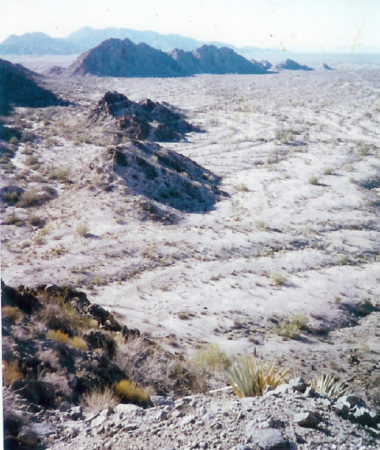
Sierra Pinacate
The Sierra Pinacate volcanic range is quickly gaining a reputation as one of the most exotic landscapes on the planet. Located only a short distance from the ocean shores of Puerto Penasco (Rocky Point) this ancient volcanic field holds one of the earth’s driest deserts. The area averages only two to four inches of rain a year and one giant crater went seven years without recorded rain.
As one might expect the plants of the Pinacates reflect the tough conditions. One of the most southern reaches of the Sonoran Desert, the landscape is still dotted with saguaros but much more common are the thick fields of teddy bear cholla which populate the cinder cone slopes like an army of tiny thorny soldiers. There are only a few scattered organ pipe cactus but there are many of the fuzzy crested senita. Particularly exotic are the multi- headed barrel cactus, interlocking thorns protecting the plants from grazing herbivores.
The geology itself looks fire blasted, the rocks appear to be just out of the furnace as lava flows sprawl in twisted shapes, the contorted sculptures of rapidly cooling molten stone. Cinder cones holding gigantic craters erupt all across the landscape. The largest of these is Crater Elegante, over 800 feet deep and 4,800 feet in diameter. Some of the lava flows are colored a rust red but most of them are jet black. All of them are striking when the glistening white sand dunes spill across them. Early Spanish pioneers named this path the “Camino Diablo” or Devil’s Road.
The first Old World explorer to travel the Camino Diablo was Melchior Diaz in 1540. Diaz was a part of the Coronado expedition as it tried to find lost cities of gold. Coronado had thought it was possible that his colony in New Mexico could be supplied by sea. Hernando Alarcon was given a ship and the best approximate directions possible to try and locate Coronado. California turned out not to be an island, and Alarcon was forced to try and navigate the Colorado River upstream. Men walked along both sides of the shore, connected to the sailing vessel by ropes as they towed the heavy vessel northward. Alarcon gave up near the junction of the Gila and Colorado River without ever reaching Coronado and without ever imagining the Grand Canyon which still lay as an obstacle up ahead. Coronado sent Melchior Diaz along the Camino Diablo to try and locate Alarcon.
The irony that Diaz became the first explorer to cross this dry and brutal desert in an attempt to reach the ocean has never ceased to amaze me. Melchior Diaz traveled this region of cactus thorns, cinder cones, and sand dunes accompanied by a half dozen conquistadors and a flock of 40 sheep. You can imagine how delighted the wolves were by this banquet of mutton on the hoof. The gray wolves must have practically drooled as they watched the plump domesticated sheep march through this inhospitable desert. The wolves howled all night while the lost conquistadors huddled by the fire and the sheep circled around, bleating nervously.
In the morning Melchior Diaz prepared for battle. The proud conquistador donned his armor, mounted his stallion and with lance in hand, charged into the fray, jousting the feral canine carnivores. Atop his galloping steed, Diaz eyed the kill and lunged…
The wolf dodged and the blade of the lance struck nothing but stone. The butt of the spear bounced back and fatally wounded the exploring conquistador. Melchior Diaz lay in the shade, slowly dying from a self inflicted groin wound, painfully aware that he was suffering perhaps the most inglorious death in all of history.
No one has ever found the lost grave of Melchior Diaz. It is one of the great mysteries of the region. The grave is so lost that no one can even say for certain whether Melchior Diaz’ remains are in the Sierra Pinacate, Gran Desierto, Cabeza Prieta Wilderness, or Organ Pipe National Monument. What is worth noting, is that when combined, these four bioreserves, (two on the American side and two on the Mexican) make up the second largest wilderness preserve on the planet – perhaps soon to be the largest depending on the extent of drilling in the Arctic Wilderness Refuge.
Sad to say, the last Mexican gray wolf disappeared from the Pinacates in the 1970’s but according to unconfirmed reports a funny thing has happened since the wolves went extinct from the region. On full moon nights sometimes you can still hear the ghosts of the wolves howl. Sometimes you can even see their shadows, just their shadows, racing across the landscape, feral ghost dogs running wild.
Suddenly the sand will shift, the earth will open, and the grave of Melchior Diaz opens wide. The ghost of Melchior Diaz rises up from the earth still riding atop his magnificent stallion, lance in his hand, preparing to battle wolves once more. The horse gallops into the darkness as the ghost wolves flee before it and Melchior Diaz aims his lance, shouting out the conquistador battle cry of “Santiago! Santiago!”
Female adventurers are safe from this ghost when they travel the Camino Diablo but male travelers must be especially wary, because like Ichabod Crane’s headless horseman, the ghost of Melchior Diaz seeks to replace that which he has lost and we all know just which particular body parts the ghost of Melchior Diaz no longer carries.
